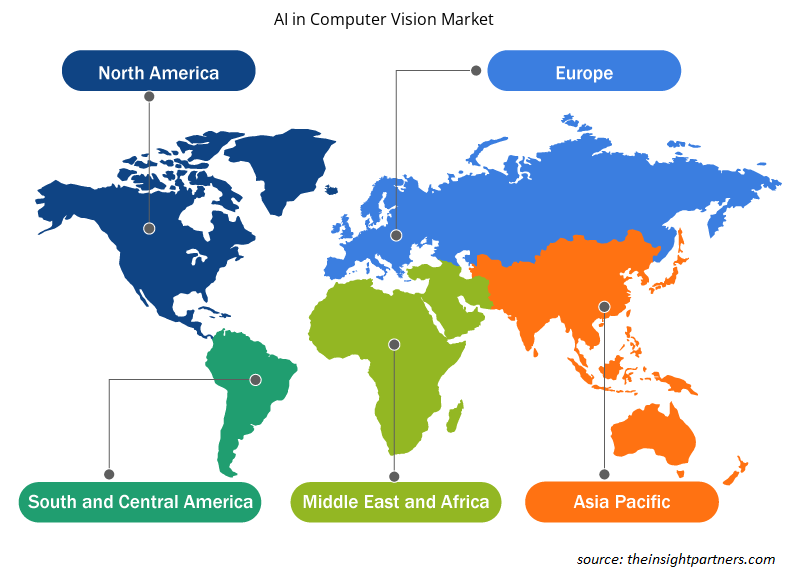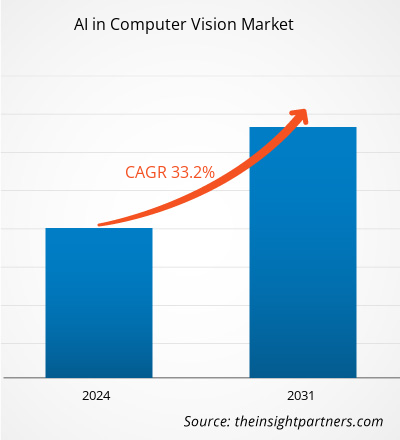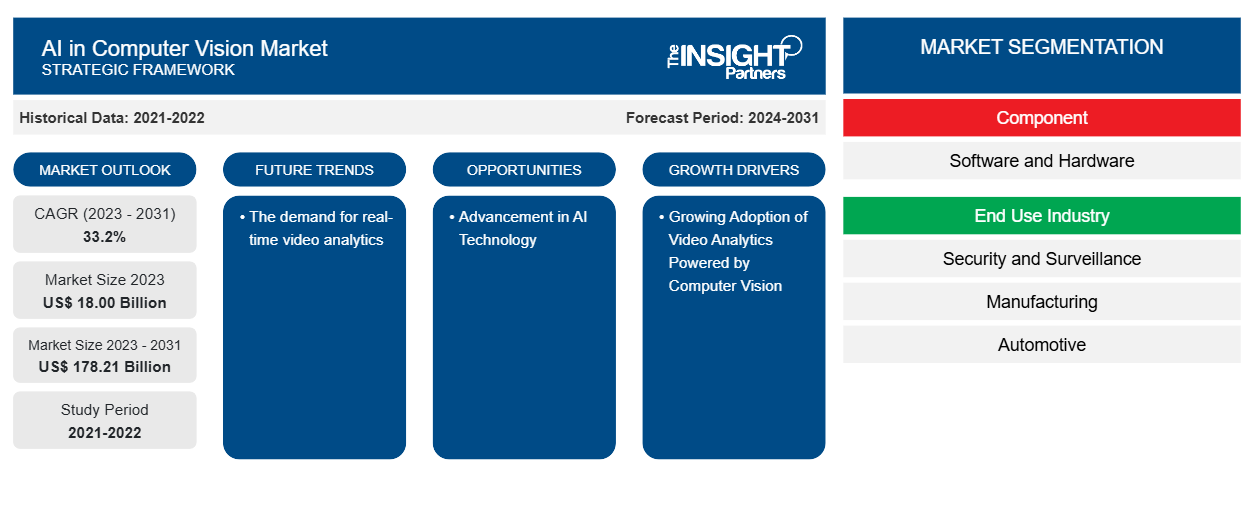[研究报告] 2022 年计算机视觉领域的人工智能市场规模价值 137.5 亿美元,预计到 2030 年将达到 1354.4 亿美元。预计 2022 年至 2030 年计算机视觉领域的人工智能市场复合年增长率为 33.1%。
分析师观点:
工业 4.0 的采用率不断增长,推动了计算机视觉市场中人工智能的发展,因为人工智能计算机视觉正在通过使自动驾驶汽车能够解释和理解视觉信息来改变工业 4.0。将人工智能与计算机视觉相结合就像拥有一支超级机器人团队在仓库和物流运营中工作。这些机器人可以根据观察到的内容进行分析、观察和决策。计算机视觉是开发自动驾驶汽车或无人驾驶汽车的基本技术。它提供了必要的感知能力,使车辆无需人工干预即可安全导航和运行。因此,自动驾驶汽车数量的不断增长推动了计算机视觉市场中人工智能的发展。
计算机视觉人工智能市场概览:
计算机视觉中的人工智能使计算机和系统能够从数字图像、视频和其他视觉输入中提取有意义的信息,并根据这些信息采取行动或做出参考。计算机视觉技术严重依赖人工智能和机器学习技术。人工智能使计算机视觉能够理解、识别和分析所有类型的视觉数据。人工智能模型、逻辑和模型可以快速消费、吸收和学习大量标记和未标记的视觉数据。它使支持计算机视觉的计算机能够识别视频、图形甚至信息图中的各种不同特征、模式和关系。
计算机视觉中的人工智能的目标是创建能够像人类一样理解视觉信息(例如图像或视频)的自动化系统。计算机视觉旨在教会机器逐像素地理解和解释图像。人工智能驱动的计算机视觉有多种用例。计算机视觉正应用于各种行业,例如安全和监控、制造、汽车、零售、体育和娱乐以及医疗保健。
定制此报告以满足您的需求
您可以免费定制任何报告,包括本报告的部分内容、国家级分析、Excel 数据包,以及为初创企业和大学提供优惠和折扣
-
获取此报告的关键市场趋势。这个免费样品将包括数据分析,从市场趋势到估计和预测。
计算机视觉市场中的人工智能驱动因素:
工业 4.0 的日益普及推动了计算机视觉市场中的人工智能增长
工业 4.0 是工业革命的新阶段——制造业和相关行业的数字化转型——高度强调自动化、互联互通、实时数据和机器学习。通过将工业 4.0 与自动化系统相结合,传统工业设施逐渐演变为智能、互联且高效的自动化设施。它形成了一个单一的自动化单元,在机器人的帮助下将计算机和工业自动化解决方案结合在一起。互联设备网络创建了一个能够做出分散决策的智能架构。工业 4.0 公司越来越多地采用基于人工智能的计算机视觉解决方案,预计将提高仓库安全性,使公司实现更高水平的精益制造,并在降低长期成本的同时提高生产力和盈利能力。
此外,人工智能计算机视觉正在通过使自动驾驶汽车能够解释和理解视觉信息来改变工业 4.0。将 人工智能和计算机视觉结合起来就像拥有一支超级机器人团队在仓库和物流运营中工作。这些机器人可以根据观察到的内容进行分析、观察和决策。这可以实现更准确、更高效、更简化的工作流程,从而提高盈利能力和生产力。在仓库和物流环境中,这些机器人可以执行质量控制、物体识别和鉴定、挑选和包装以及库存管理等任务。它们有助于加快工作速度并消除人为错误的可能性,确保正确的产品准时送达正确的客户并确保运营顺利进行。
人工智能计算机视觉通过减少人为错误、自动化任务、提高生产力、基于实时数据实现智能决策以及确保产品质量,彻底改变了行业流程。人工智能计算机视觉系统在工业 4.0 自动化领域有多种应用。借助计算机视觉,它可以精确快速地测量产品数量、降低成本和时间、避免特定加工过程中的人为接触以消除污染风险,并为员工提供更好的安全标准。人工智能计算机视觉在工业领域发展迅速,因为它为生产线提供了可集成的解决方案。计算机视觉系统可以执行多种操作,包括监控产品、分析可能的缺陷、执行预测性维护以避免故障和中断以及提高生产现场的安全性。因此,随着工业 4.0 的日益普及,计算机视觉市场中的人工智能正在增长。
计算机视觉市场中的人工智能报告细分和范围:
计算机视觉中的人工智能市场分为组件、最终用途行业和地理区域。根据组件,计算机视觉中的人工智能市场分为硬件和软件。就最终用途行业而言,计算机视觉中的人工智能市场分为安全与监控、制造、汽车、零售、体育与娱乐等。按地理区域划分,计算机视觉中的人工智能市场分为北美、欧洲、亚太地区、中东和非洲以及南美。
计算机视觉市场中的人工智能细分分析:
根据组件,计算机视觉中的人工智能市场细分为硬件和软件。2022 年,软件部分在计算机视觉中的人工智能市场中占有较大的份额。软件通过提供分析和可视化数据所需的工具,在计算机视觉中的人工智能中发挥着重要作用。软件提供了多种应用程序,例如 AI 框架、AI 例程、视频处理、图像采集、图像处理控制和人工智能功能,以设计、开发和部署高性能计算机视觉应用程序。多家公司为计算机视觉中的人工智能提供软件。例如,Advanced Micro Devices Inc. 提供 AMD ROCm 软件。该软件为 AI 工作负载提供了一套优化——从大型语言模型 (LLM) 到图像/视频检测和识别、生命科学和药物发现、自动驾驶、机器人技术等——并支持更广泛的 AI 软件生态系统,包括开放框架、模型和工具。
在计算机视觉应用中,硬件在数据捕获方面起着重要作用。计算机视觉应用所需的主要硬件元素包括处理器单元、输入/输出设备 (I/O)、用于图像捕获的摄像头和 图像传感器以及通信链路。摄像头成像传感器有三个关键参数:分辨率(像素数)、速度(每秒帧数)和颜色数。根据计算机视觉应用的类型,处理单元从 CPU 到嵌入式主板不等。全球有多家公司提供计算机视觉硬件。例如,Qualcomm Technologies, Inc. 提供 Vision AI 开发套件,用于在智能边缘设备上运行人工智能模型。Vision AI 开发套件包括主板、摄像头等。
计算机视觉市场中的人工智能区域分析:
2022 年,北美计算机视觉人工智能市场规模为 50.1 亿美元,预计到 2030 年将达到 511.2 亿美元;预计 2022 年至 2030 年的复合年增长率为 33.7%。北美计算机视觉人工智能市场分为美国、加拿大和墨西哥。2022 年,美国占据北美计算机视觉人工智能市场的最大份额。美国的一些商业组织以及联邦和州政府通过迅速采用人工智能技术促进工业和经济发展,为市场的增长做出了贡献。作为美国的金融和技术中心,纽约在人工智能集成和应用质量方面表现尤为出色。此外,政府在全国范围内实施的智慧城市计划也有望影响全国范围内对计算机视觉人工智能技术的采用。美国各家公司都在推出计算机视觉技术。例如,2023 年 5 月,领先的计算机视觉云平台 Landing AI 宣布推出全球首款针对 FDA 监管制造商的计算机视觉软件。该平台版本针对药品、医疗器械制造商和生命科学等监管严格的行业,以便他们能够加快创新解决方案。因此,计算机视觉市场的人工智能在美国正在增长。
计算机视觉市场中的人工智能关键参与者分析:
超微半导体公司 (Advanced Micro Devices Inc.)、康耐视公司、通用电气公司、英特尔公司、微软公司、高通公司、Teledyne Technologies Inc.、NVIDIA 公司、巴斯勒公司 (BASLER AG) 和国际商业机器公司 (International Business Machines Corp.) 是计算机视觉市场人工智能领域的主要公司。
计算机视觉市场中的人工智能区域洞察
Insight Partners 的分析师详细解释了预测期内影响计算机视觉市场 AI 的区域趋势和因素。本节还讨论了计算机视觉市场 AI 的细分市场和地理位置,包括北美、欧洲、亚太地区、中东和非洲以及南美和中美洲。

- 获取计算机视觉市场中人工智能的区域特定数据
计算机视觉市场中的人工智能报告范围
| 报告属性 | 细节 |
|---|---|
| 2023 年的市场规模 | 180亿美元 |
| 2031 年市场规模 | 1782.1亿美元 |
| 全球复合年增长率(2023 - 2031) | 33.2% |
| 史料 | 2021-2022 |
| 预测期 | 2024-2031 |
| 涵盖的领域 |
按组件
|
| 覆盖地区和国家 |
北美
|
| 市场领导者和主要公司简介 |
|
计算机视觉市场参与者密度中的人工智能:了解其对业务动态的影响
计算机视觉市场中的人工智能正在快速增长,这得益于终端用户需求的不断增长,这些需求源于消费者偏好的不断变化、技术进步以及对产品优势的认识不断提高等因素。随着需求的增加,企业正在扩大其产品范围,进行创新以满足消费者的需求,并利用新兴趋势,从而进一步推动市场增长。
市场参与者密度是指在特定市场或行业内运营的企业或公司的分布情况。它表明在给定市场空间中,相对于其规模或总市场价值,有多少竞争对手(市场参与者)存在。
在计算机视觉市场中运营人工智能的主要公司有:
- 美国超微半导体公司
- 康耐视公司
- 通用电气公司
- 英特尔公司
- 微软公司
- 高通公司
免责声明:上面列出的公司没有按照任何特定顺序排列。

- 了解计算机视觉市场中的人工智能顶级关键参与者概况
计算机视觉市场人工智能的最新发展:
计算机视觉 AI 市场中的公司大量采用并购等无机和有机策略。以下列出了计算机视觉 AI 市场中的一些最新关键发展:
- 2022 年 2 月,AMD 宣布收购美国半导体供应商赛灵思。收购后,赛灵思将作为 AMD 自适应和嵌入式计算集团的一部分运营。两家公司提供互补产品,具有差异化的 IP 和员工队伍。通过合作,AMD 和赛灵思将能够提供更广泛的产品和解决方案,满足计算解决方案的各种需求。
- 2023 年 3 月,英特尔实验室通过两种新的 AI 模型增强了计算机视觉开发。VI-Depth 1.0 和 MiDaS 3.1 开源 AI 模型改进了计算机视觉的深度估计。
- 历史分析(2 年)、基准年、预测(7 年)及复合年增长率
- PEST和SWOT分析
- 市场规模、价值/数量 - 全球、区域、国家
- 行业和竞争格局
- Excel 数据集
近期报告
相关报告
客户评价
购买理由
- 明智的决策
- 了解市场动态
- 竞争分析
- 客户洞察
- 市场预测
- 风险规避
- 战略规划
- 投资论证
- 识别新兴市场
- 优化营销策略
- 提升运营效率
- 顺应监管趋势























 获取免费样品 - 计算机视觉市场中的人工智能
获取免费样品 - 计算机视觉市场中的人工智能